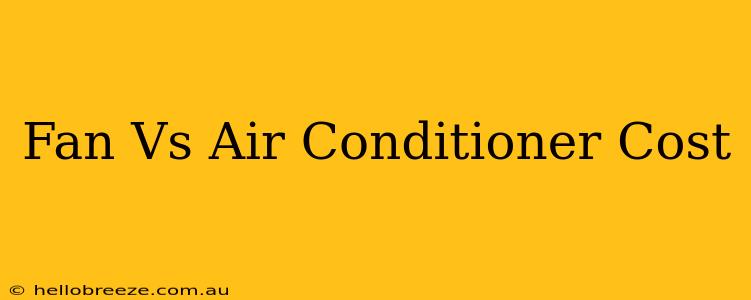Choosing between a fan and an air conditioner often comes down to budget and climate. Both offer cooling solutions, but their costs differ significantly in terms of purchase price, running costs, and long-term maintenance. This comprehensive guide breaks down the financial implications of each to help you make an informed decision.
Initial Purchase Costs: Fan vs. Air Conditioner
The most immediate difference lies in the upfront cost. Fans are significantly cheaper than air conditioners. You can find a decent quality ceiling fan or even a powerful tower fan for a fraction of the price of even the most basic air conditioning unit.
- Fans: Expect to pay anywhere from $20 to $300, depending on the type (desk fan, tower fan, ceiling fan), features (oscillation, remote control, timer), and brand.
- Air Conditioners: Prices range widely, from a few hundred dollars for a small window unit to thousands for a central air conditioning system or a high-efficiency ductless mini-split.
Factors Affecting Air Conditioner Costs:
- Type: Window units are generally the cheapest, followed by portable units, ductless mini-splits, and finally, central air systems.
- BTU Rating: Higher BTU (British Thermal Units) ratings mean more cooling power, translating to a higher price tag.
- Energy Efficiency (SEER Rating): A higher Seasonal Energy Efficiency Ratio (SEER) rating indicates lower operating costs, but these models typically cost more upfront.
- Features: Smart features, like Wi-Fi connectivity and programmable thermostats, add to the initial cost.
Running Costs: Energy Consumption & Savings
While the initial investment is lower for fans, the ongoing operational costs present a different picture. Fans consume significantly less energy than air conditioners. This translates to lower electricity bills throughout the cooling season.
- Fans: Even powerful fans draw relatively little power, making them a budget-friendly option for daily use.
- Air Conditioners: Air conditioners are energy-intensive appliances. Their running costs depend heavily on the unit's efficiency (SEER rating), the size of the space being cooled, and how often it runs.
Minimizing Air Conditioner Running Costs:
- Choose a High SEER Rating: Higher SEER means lower long-term energy consumption.
- Properly Size Your AC Unit: An undersized unit will work harder and consume more energy.
- Regular Maintenance: Cleaning filters and scheduling professional maintenance will extend the life of your unit and improve efficiency.
- Utilize Smart Features: Programmable thermostats and smart AC controls can help optimize energy use.
Long-Term Costs: Maintenance and Lifespan
Both fans and air conditioners require some maintenance, but the complexity and cost differ.
- Fans: Generally require minimal maintenance, primarily cleaning the blades periodically. They have a relatively long lifespan, often lasting for many years.
- Air Conditioners: Require more frequent maintenance, including filter cleaning, coil cleaning, and potentially professional servicing. Air conditioners have a shorter lifespan than fans, typically ranging from 10-15 years, depending on use and maintenance.
Which is Right for You?
The best choice depends on your individual needs and circumstances:
-
For budget-conscious individuals in areas with mild summers: A fan might be the ideal choice. It's inexpensive to purchase and operate, providing adequate cooling in less extreme temperatures.
-
For those living in hot and humid climates or needing powerful cooling: An air conditioner is essential for comfort. While the upfront and running costs are higher, the improved comfort level might outweigh these expenses.
In conclusion: While fans provide a cost-effective cooling solution for milder climates, air conditioners offer superior cooling power for hotter environments, albeit at a higher initial and operational cost. Carefully weigh the initial investment, running costs, and long-term maintenance needs to select the most suitable cooling solution for your specific situation.

